Bird R.B., Stewart W.E., Lightfoot E.N. Transport Phenomena
Подождите немного. Документ загружается.

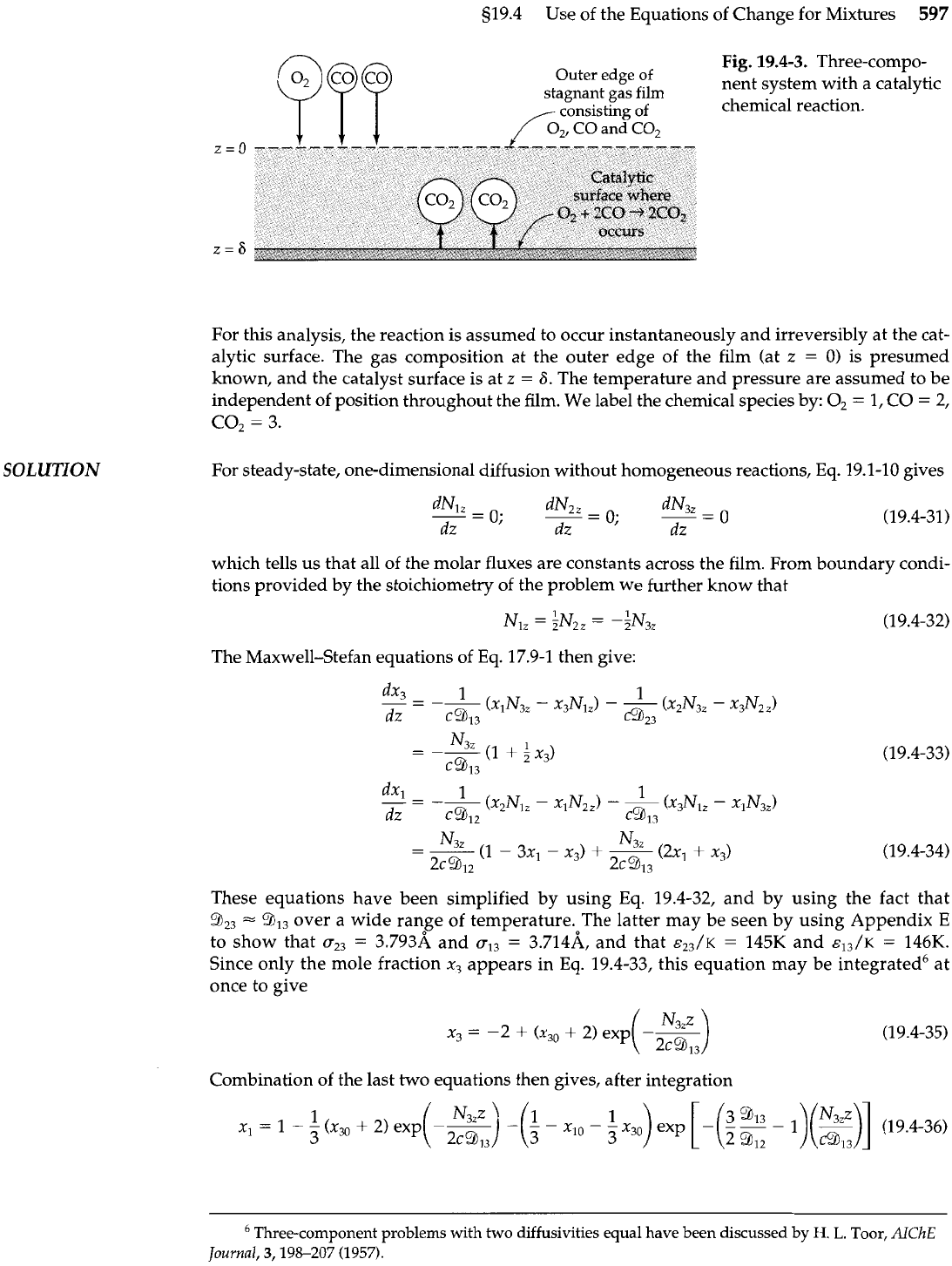
519.4 Use of the Equations of Change for Mixtures
597
SOLUTION
Fig.
19.4-3.
Three-compo-
Outer edge of
nent system with a catalytic
stagnant gas film
,-
consisting
of
chemical reaction.
For this analysis, the reaction is assumed to occur instantaneously and irreversibly at the cat-
alytic surface. The gas composition at the outer edge of the film (at
z
=
0)
is presumed
known, and the catalyst surface is at
z
=
6.
The temperature and pressure are assumed to be
independent of position throughout the film. We label the chemical species by: O2
=
1,
CO
=
2,
co2
=
3.
For steady-state, one-dimensional diffusion without homogeneous reactions, Eq. 19.1-10 gives
which tells us that all of the molar fluxes are constants across the film. From boundary condi-
tions provided by the stoichiometry of the problem we further know that
The Maxwell-Stefan equations of Eq. 17.9-1 then give:
These equations have been simplified by using Eq. 19.4-32, and by using the fact that
9,,
-
9,,
over
a
wide range of temperature. The latter may be seen by using Appendix
E
to show that
a,,
=
3.793A and
a,,
=
3.714A, and that
E~~/K
=
145K and
E,,/K
=
146K.
Since only the mole fraction
x3
appears in
Eq.
19.4-33, this equation may be integrated6 at
once to give
x,
=
-2
+
(x,
+
2)
exp
--
(
2:)
Combination of the last two equations then gives, after integration
1
i
N3zz
)
(1
-
xI0
-
5
x30)
exp
[-(2
3
913
-
I)(%)] (19-4-36)
x,
=
1
-
-
(x,,
+
2) exp
--
3
2~91,
3
Three-component problems with two diffusivities equal have been discussed by
H.
L.
Toor,
AIChE
Journal,
3,198-207 (1957).
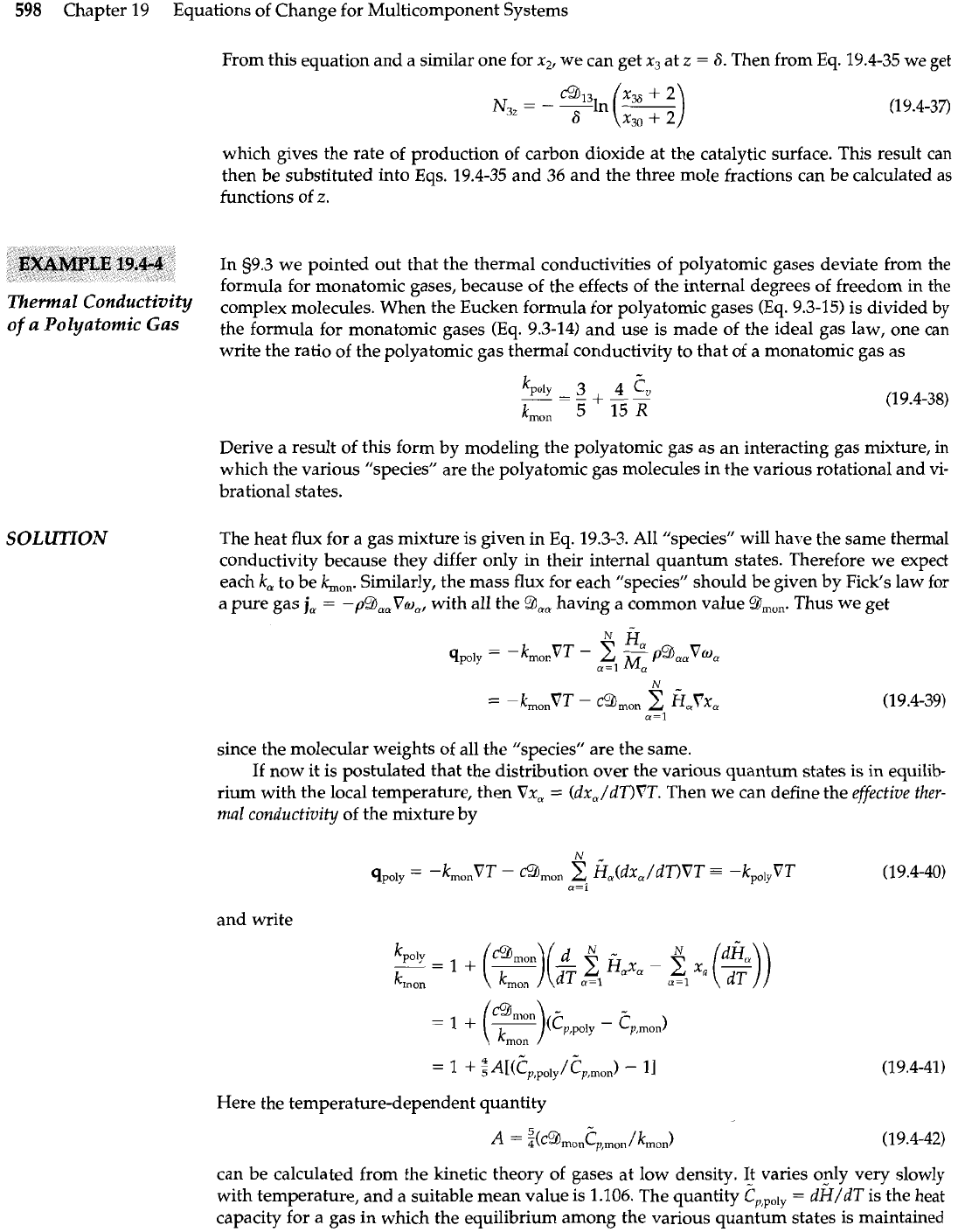
598
Chapter
19
Equations of Change for Multicomponent Systems
EXAMPLE
19.4-4
Thermal Conductivity
of
a
Polyatomic Gas
SOLUTION
From this equation and a similar one for
x2,
we can get
x,
at
z
=
8.
Then from Eq.
19.4-35
we get
which gives the rate of production of carbon dioxide at the catalytic surface. This result can
then be substituted into Eqs.
19.4-35
and
36
and the three mole fractions can be calculated as
functions of
z.
In
59.3
we pointed out that the thermal conductivities of polyatomic gases deviate from the
formula for monatomic gases, because of the effects of the internal degrees of freedom in the
complex molecules. When the Eucken formula for polyatomic gases (Eq.
9.3-15)
is divided
by
the formula for monatomic gases (Eq.
9.3-14)
and use is made of the ideal gas law, one can
write the ratio of the polyatomic gas thermal conductivity to that of a monatomic gas as
Derive a result of this form by modeling the polyatomic gas as an interacting gas mixture, in
which the various "species" are the polyatomic gas molecules in the various rotational and vi-
brational states.
The heat flux for
a
gas mixture is given in Eq.
19.3-3.
All "species" will have the same thermal
conductivity because they differ only in their internal quantum states. Therefore we expect
each
k,
to be
Lon.
Similarly, the mass flux for each "species" should be given by Fick's law
for
a pure gas
j,
=
-pB,,Vw,,
with all the
a,,
having a common value
9,,,.
Thus we get
since the molecular weights of all the "species" are the same.
If now it is postulated that the distribution over the various quantum states is in equilib-
rium with the local temperature, then
Vx,
=
(dx,/dT)VT.
Then we can define the
effective ther-
mal
conductivity
of the mixture by
and write
kp0ly
--
-1+
kon
=1+
=1+
Here the temperature-dependent quantity
can be calculated from the kinetic theory of gases at low density. It varies ogly very slowly
with temperature, and a suitable mean value is
1.106.
The quantity
~p,poIy
=
dH/dT
is the heat
capacity for a gas in which the equilibrium among the various quantum states is maintained
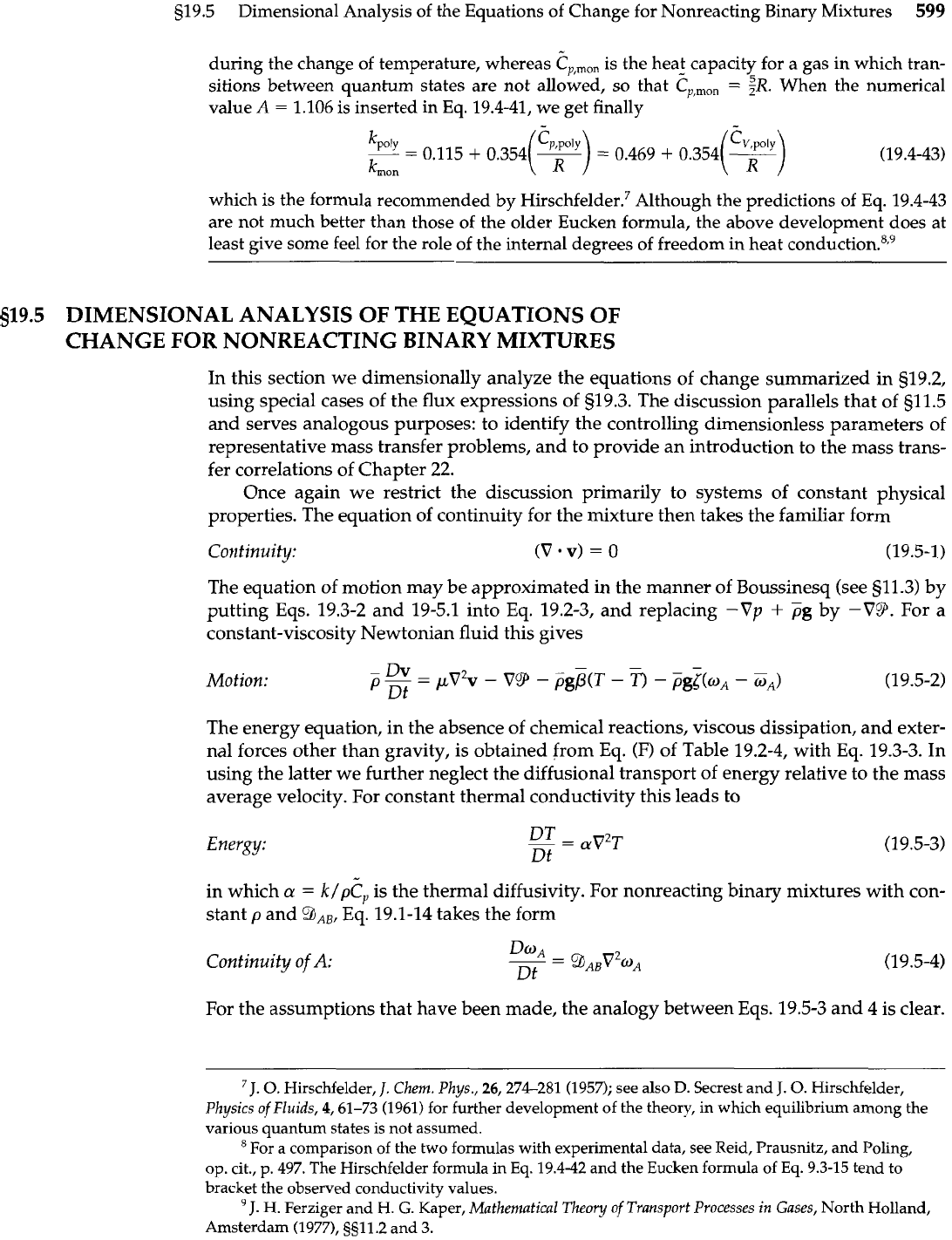
519.5
Dimensional Analysis of the Equations of Change for Nonreacting Binary Mixtures
599
-
during the change of temperature, whereas
Cp,m,,
is the heat capacity for a gas in which tran-
sitions between quantum states are not allowed, so that
C,,,,,
=
$R.
When the numerical
value
A
=
1.106 is inserted in
Eq.
19.4-41, we get finally
which is the formula recommended by Hir~chfelder.~ Although the predictions of Eq. 19.4-43
are not much better than those of the older Eucken formula, the above development does at
least give some feel for the role of the internal degrees of freedom in heat cond~ction.~,~
519.5
DIMENSIONAL ANALYSIS OF THE EQUATIONS OF
CHANGE FOR NONREACTING BINARY MIXTURES
In this section we dimensionally analyze the equations of change summarized in 519.2,
using special cases of the flux expressions of 919.3. The discussion parallels that of 511.5
and serves analogous purposes: to identify the controlling dimensionless parameters of
representative mass transfer problems, and to provide an introduction to the mass trans-
fer correlations of Chapter 22.
Once again we restrict the discussion primarily to systems of constant physical
properties. The equation of continuity for the mixture then takes the familiar form
Continuity:
(V
.
v)
=
0
(19.5-1)
The equation of motion may be approximated in the manner of Boussinesq (see g11.3) by
putting Eqs. 19.3-2 and 19-5.1 into
Eq.
19.2-3, and replacing
-Vp
+
pg
by
-V9.
For a
constant-viscosity Newtonian fluid this gives
Motion:
The energy equation, in the absence of chemical reactions, viscous dissipation, and exter-
nal forces other than gravity, is obtained from Eq. (F) of Table 19.2-4, with Eq. 19.3-3. In
using the latter we further neglect the diffusional transport of energy relative to the mass
average velocity. For constant thermal conductivity this leads to
Energy:
in which
n
=
k/p?,,
is the thermal diffusivity. For nonreacting binary mixtures with con-
stant
p
and
B,,,
Eq. 19.1-14 takes the form
Continuity of
A:
For the assumptions that have been made, the analogy between Eqs. 19.5-3 and 4 is clear.
-
-
-
J.
0.
Hirschfelder,
1.
Chem.
Phys.,
26,274-281 (1957); see also
D.
Secrest and
J.
0.
Hirschfelder,
Physics of
Fluids,
4,61-73 (1961) for further development of the theory, in wluch equilibrium among the
various quantum states is not assumed.
For a comparison
of
the two formulas with experimental data, see Reid, Prausnitz, and Poling,
op. cit.,
p.
497. The Hirschfelder formula in Eq.
19.4-42
and the Eucken formula of Eq. 9.3-15 tend to
bracket the observed conductivity values.
'
J.
H.
Ferziger and H.
G.
Kaper,
Mathematical
Theory
of Transport Processes in Gases,
North Holland,
Amsterdam (1977), g511.2 and
3.
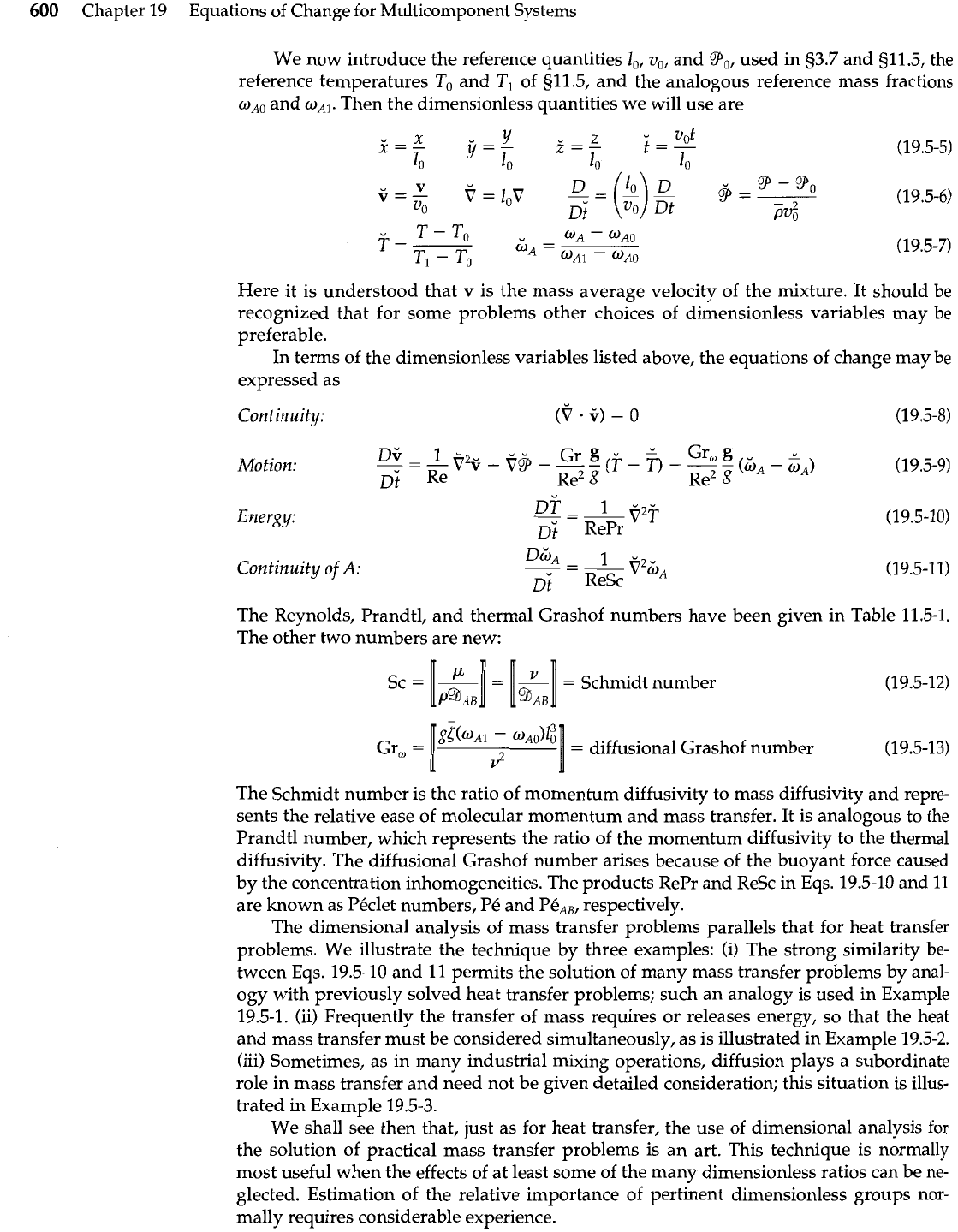
600
Chapter 19 Equations of Change for Multicomponent Systems
We now introduce the reference quantities
I,,
v,, and Yo, used
in
93.7 and 911.5, the
reference temperatures
To
and
T,
of 511.5, and the analogous reference mass fractions
o,,
and w,,. Then the dimensionless quantities we will use are
Here it is understood that
v
is the mass average velocity of the mixture. It should be
recognized that for some problems other choices of dimensionless variables may be
preferable.
In terms of the dimensionless variables listed above, the equations of change may be
expressed as
Continuity:
(9
.
i;)
=
0 (1 9.5-8)
Motion:
Energy:
Continuity of
A:
--
~i
RePr
DGA
-
I
v2&A
~i
ReSc
The Reynolds, Prandtl, and thermal Grashof numbers have been given in Table 11.5-1.
The other two numbers are new:
sc
=
1-1
=
=
Schmidt number
PB
AB
Gr,
=
[gi(w~l
-
mAu)C]
=
diffusional Grashof number
4
The Schmidt number is the ratio of momentum diffusivity to mass diffusivity and repre-
sents the relative ease of molecular momentum and mass transfer. It is analogous to the
Prandtl number, which represents the ratio of the momentum diffusivity to the thermal
diffusivity. The diffusional Grashof number arises because of the buoyant force caused
by the concentration inhomogeneities. The products RePr and ReSc in Eqs. 19.5-10 and 11
are known as Pkclet numbers, Pk and PkAB, respectively.
The dimensional analysis of mass transfer problems parallels that for heat transfer
problems. We illustrate the technique by three examples: (i) The strong similarity be-
tween Eqs. 19.5-10 and 11 permits the solution of many mass transfer problems by anal-
ogy with previously solved heat transfer problems; such an analogy is used in Example
19.5-1. (ii) Frequently the transfer of mass requires or releases energy, so that the heat
and mass transfer must be considered simultaneously, as is illustrated in Example 19.5-2.
(iii) Sometimes, as in many industrial mixing operations, diffusion plays a subordinate
role in mass transfer and need not be given detailed consideration; this situation is illus-
trated in Example 19.5-3.
We shall see then that, just as for heat transfer, the use of dimensional analysis for
the solution of practical mass transfer problems is an art. This technique is normally
most useful when the effects of at least some of the many dimensionless ratios can be ne-
glected. Estimation of the relative importance of pertinent dimensionless groups nor-
mally requires considerable experience.
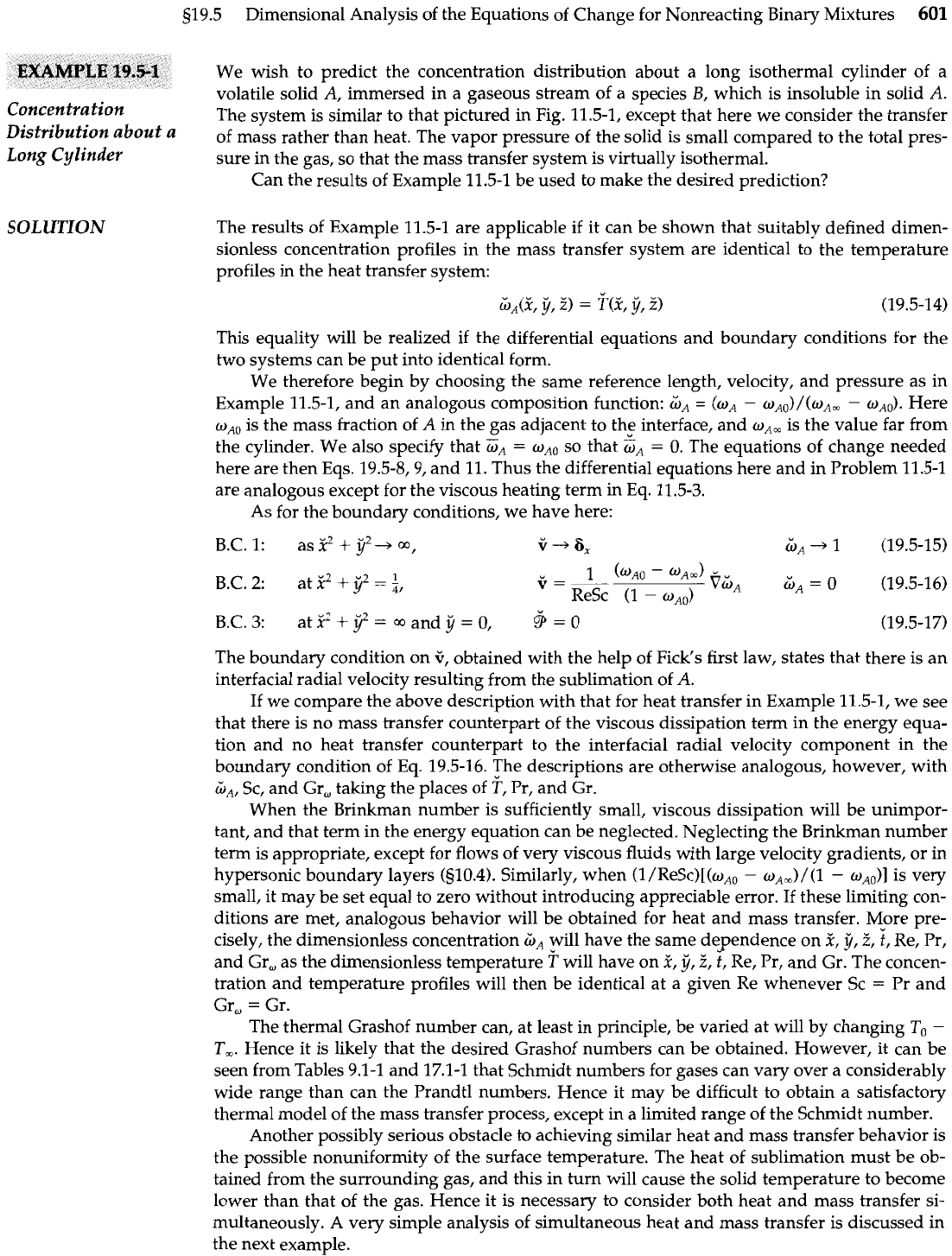
519.5
Dimensional Analysis of the Equations of Change for Nonreacting Binary Mixtures
601
We wish to predict the concentration distribution about a long isothermal cylinder of a
volatile solid
A,
immersed in a gaseous stream of a species
B,
which is insoluble in solid
A.
Concentration
The system is similar to that pictured in Fig. 11.5-1, except that here we consider the transfer
Distribution about a
of mass rather than heat. The vapor pressure of the solid is small compared to the total pres-
Long Cylinder
sure in the gas, so that the mass transfer system is virtually isothermal.
Can the results of Example 11.5-1 be used to make the desired prediction?
SOLUTION
The results of Example 11.5-1 are applicable if it can be shown that suitably defined dimen-
sionless concentration profiles in the mass transfer system are identical to the temperature
profiles in the heat transfer system:
ijA(X,
ij,
2)
=
f(X,
ij,
i)
(19.5-14)
This equality will be realized if the differential equations and boundary conditions for the
two systems can be put into identical form.
We therefore begin by choosing the same reference length, velocity, and pressure as in
Example 11.5-1, and an analogous composition function:
ij,
=
(w,
-
w~~)/(o~~
-
~~~1. Here
w,,
is the mass fraction of
A
in the gas adjacent to ths interface, and
wAco
is the value far from
the cylinder. We also specify that
ZA
=
w,,
so that
&
=
0.
The equations of change needed
here are then Eqs. 19.5-8,9, and 11. Thus the differential equations here and in Problem 11.5-1
are analogous except for the viscous heating term in Eq. 11.5-3.
As for the boundary conditions, we have here:
B.C.
1: as
X2
+
ij2
+
m,
c
+
tix
+
1 (19.5-15)
B.C.
2:
at f2
+
ij2
=
Z
1
(wA0
-
@Am)
v=-
Vij,
ijA
=
0
(19.5-16)
ReSc (I
-
wA0)
The boundary condition on
+,
obtained with the help of Fick's first law, states that there is an
interfacial radial velocity resulting from the sublimation of
A.
If we compare the above description with that for heat transfer in Example 11.5-1, we see
that there is no mass transfer counterpart of the viscous dissipation term in the energy equa-
tion and no heat transfer counterpart to the interfacial radial velocity component in the
boundary condition of
Eq.
19.5-16. The descriptions are otherwise analogous, however, with
G,,
Sc, and Gr, taking the places of
T,
Pr, and Gr.
When the Brinkman number is sufficiently small, viscous dissipation will be unimpor-
tant, and that term in the energy equation can be neglected. Neglecting the Brinkman number
term is appropriate, except for flows of very viscous fluids with large velocity gradients, or in
hypersonic boundary layers (510.4). Similarly, when (l/ReSc)[(w,,
-
wA,)/(l
-
wAo)l
is very
small, it may be set equal to zero without introducing appreciable error. If these limiting con-
ditions are met, analogous behavior will be obtained for heat and mass transfer. More pre-
cisely, the dimensionless concentration
G,
will have the same dependence on
i,
q,Z,
i,
Re, Pr,
and Gr, as the dimensionless temperature
?
will have on f,
jl,
i,
t,
Re, Pr, and Gr. The concen-
tration and temperature profiles will then be identical at a given Re whenever Sc
=
Pr and
Gr,
=
Gr.
The thermal Grashof number can, at least in principle, be varied at will by changing To
-
T,.
Hence it is likely that the desired Grashof numbers can be obtained. However, it can be
seen from Tables 9.1-1 and 17.1-1 that Schmidt numbers for gases can vary over a considerably
wide range than can the Prandtl numbers. Hence it may be difficult to obtain a satisfactory
thermal model of the mass transfer process, except in a limited range of the Schmidt number.
Another possibly serious obstacle to achieving similar heat and mass transfer behavior is
the possible nonuniformity of the surface temperature. The heat of sublimation must be ob-
tained from the surrounding gas, and this in turn will cause the solid temperature to become
lower than that of the gas. Hence it is necessary to consider both heat and mass transfer si-
multaneously. A very simple analysis of simultaneous heat and mass transfer is discussed in
the next example.
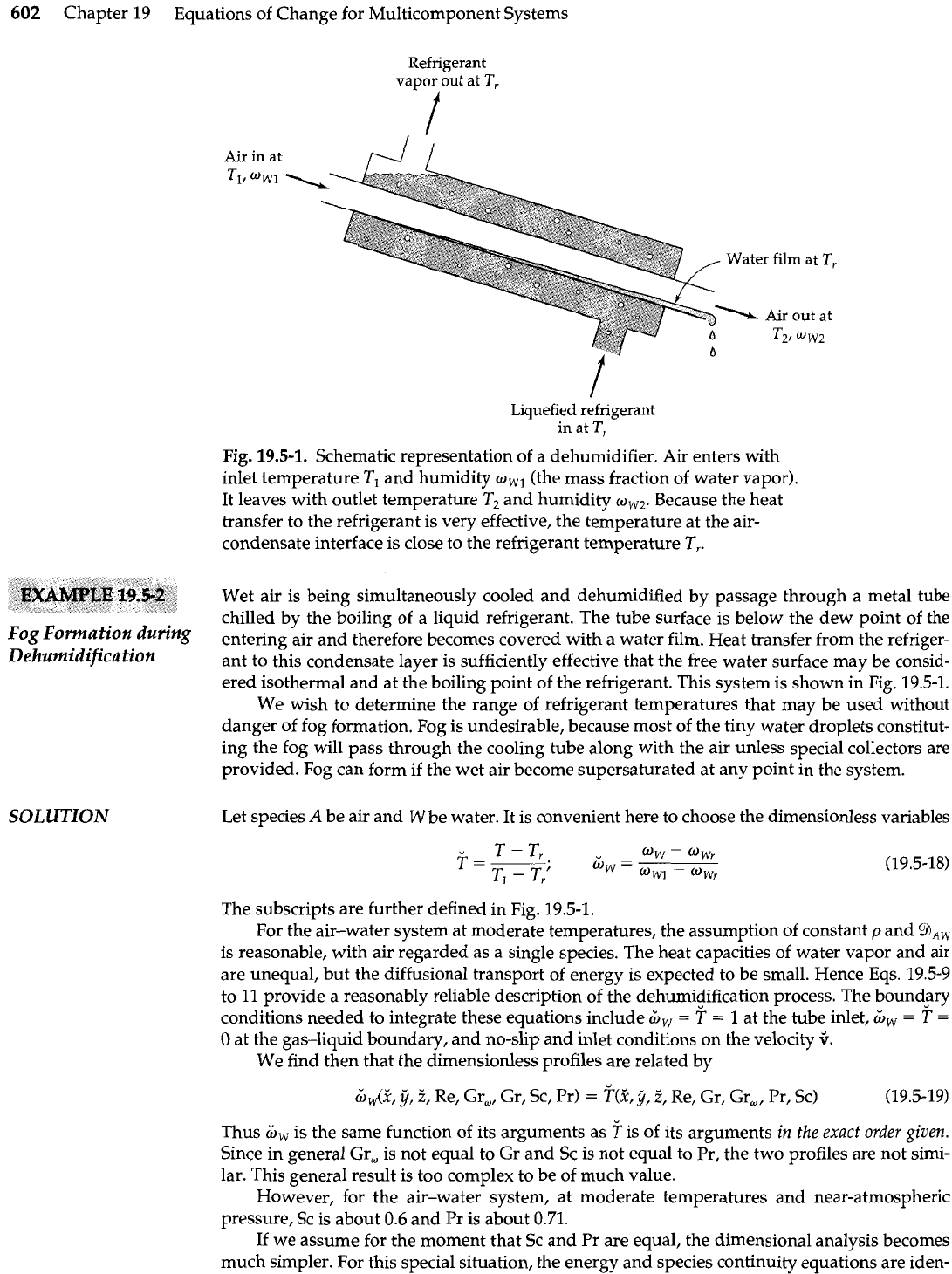
602
Chapter 19 Equations of Change for Multicomponent Systems
EXAMPLE
19.5-2
Fog Formation during
Dehumidification
SOLUTION
Refrigerant
vapor
out
at
Tr
Air in
at
d
/
Liquefied refrigerant
in
at
T,
Fig.
19.5-1.
Schematic representation of a dehumidifier. Air enters with
inlet temperature
TI
and humidity
owl
(the mass fraction of water vapor).
It leaves with outlet temperature
T2
and humidity
ow,
Because the heat
transfer to the refrigerant
is
very effective, the temperature at the air-
condensate interface is close to the refrigerant temperature
T,.
Wet air is being simultaneously cooled and dehumidified by passage through a metal tube
chilled by the boiling of a liquid refrigerant. The tube surface is below the dew point of the
entering air and therefore becomes covered with a water film. Heat transfer from the refriger-
ant to this condensate layer is sufficiently effective that the free water surface may be consid-
ered isothermal and at the boiling point of the refrigerant. This system is shown in Fig. 19.5-1.
We wish to determine the range of refrigerant temperatures that may be used without
danger of fog formation. Fog is undesirable, because most of the tiny water droplets constitut-
ing the fog will pass through the cooling tube along with the air unless special collectors are
provided. Fog can form if the wet air become supersaturated at any point in the system.
Let species
A
be air and
W
be water. It is convenient here to choose the dimensionless variables
The subscripts are further defined in Fig. 19.5-1.
For the air-water system at moderate temperatures, the assumption of constant
p
and
BAW
is reasonable, with air regarded as a single species. The heat capacities of water vapor and air
are unequal, but the diffusional transport of energy is expected to be small. Hence Eqs. 19.5-9
to
11
provide a reasonably reliable description of the dehumidification process. The boundary
conditions needed to integrate these equations include
L,
=
i
=
1
at the tube inlet,
Lw
=
!f
=
0
at the gas-liquid boundary, and no-slip and inlet conditions on the velocity
G.
We find then that the dimensionless profiles are related by
ijw(f,
9,
if
Re, Gr,, Gr, Sc, Pr)
=
?(?,
ij,
2,
Re, Gr, Gr,, Pr, Sc)
(19.5-19)
Thus
ZiW
is the same function of its arguments as
f
is of its arguments
in
the
exact
order
given.
Since in general Gr, is not equal to Gr and Sc is not equal to Pr, the two profiles are not simi-
lar. This general result is too complex to be of much value.
However, for the air-water system, at moderate temperatures and near-atmospheric
pressure, Sc is about
0.6
and Pr is about 0.71.
If we assume for the moment that Sc and Pr are equal, the dimensional analysis becomes
much simpler. For this special situation, the energy and species continuity equations are iden-
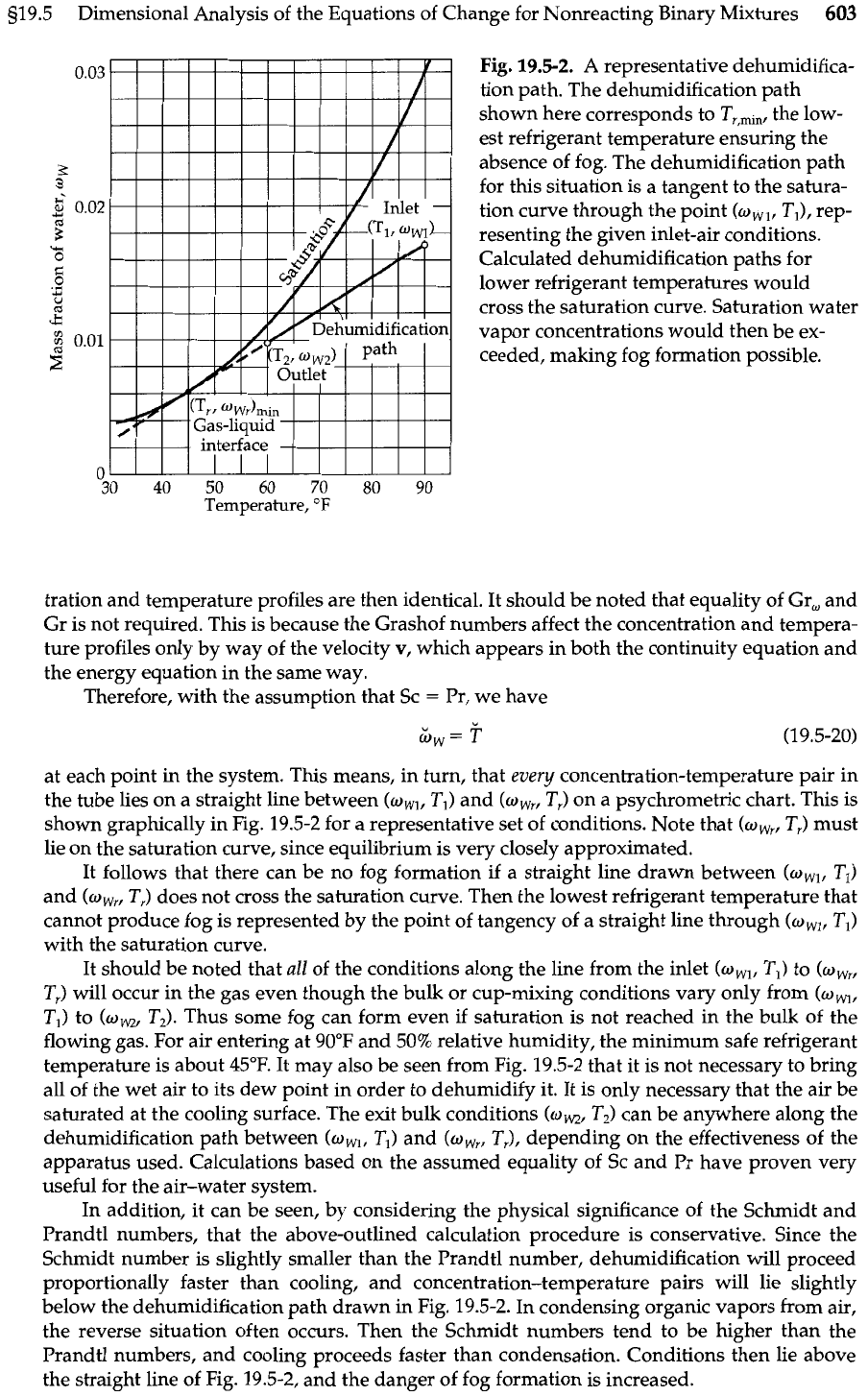
g19.5
Dimensional Analysis of the Equations of Change for Nonreacting Binary Mixtures
603
Fig.
19.5-2.
A
representative dehumidifica-
tion path. The dehumidification path
shown here corresponds to T,,,,,, the low-
est refrigerant temperature ensuring the
absence of fog. The dehumidification path
for this situation is a tangent to the satura-
tion curve through the point
(w,,,
T,), rep-
resenting the given inlet-air conditions.
Calculated dehumidification paths for
lower refrigerant temperatures would
cross the saturation curve. Saturation water
vapor concentrations would then be ex-
ceeded, making fog formation possible.
0
L
30
40
50
60
70
80
90
Temperature,
OF
tration and temperature profiles are then identical. It should be noted that equality of Gr, and
Gr is not required. This is because the Grashof numbers affect the concentration and tempera-
ture profiles only by way of the velocity
v,
which appears in both the continuity equation and
the energy equation in the same way.
Therefore, with the assumption that Sc
=
Pr, we have
at each point
in
the system. This means, in turn, that
evey
concentration-temperature pair in
the tube lies on a straight line between
(owl,
Tl) and (ow,
T,)
on a psychrometric chart. This is
shown graphically in Fig. 19.5-2 for
a
representative set of conditions. Note that
(w,,.,
Tr) must
lie on the saturation curve, since equilibrium is very closely approximated.
It follows that there can be no fog formation if a straight line drawn between
(w,,
TI)
and
(w,,,
T,) does not cross the saturation curve. Then the lowest refrigerant temperature that
cannot produce fog is represented by the point of tangency of a straight line through
(ow,
TI)
with the saturation curve.
It should be noted that
all
of the conditions along the line from the inlet
(ow,,
TI) to
(w,,
T,) will occur in the gas even though the bulk or cup-mixing conditions vary only from
(w,,
TI) to
(o,,
T,). Thus some fog can form even if saturation is not reached in the bulk of the
flowing gas. For air entering at 90°F and 50% relative humidity, the minimum safe refrigerant
temperature is about 45°F. It may also be seen from Fig. 19.5-2 that it is not necessary to bring
all of the wet air to its dew point in order to dehumidify it. It is only necessary that the air be
saturated at the cooling surface. The exit bulk conditions
(w,,
T,) can be anywhere along the
dehumidification path between
(w,,
TI)
and (w,,
TJ,
depending on the effectiveness of the
apparatus used. Calculations based on the assumed equality of Sc and Pr have proven very
useful for the air-water system.
In addition, it can be seen, by considering the physical significance of the Schmidt and
Prandtl numbers, that the above-outlined calculation procedure is conservative. Since the
Schmidt number is slightly smaller than the Prandtl number, dehumidification will proceed
proportionally faster than cooling, and concentration-temperature pairs will lie slightly
below the dehumidification path drawn in Fig. 19.5-2. In condensing organic vapors from air,
the reverse situation often occurs. Then the Schmidt numbers tend to be higher than the
Prandtl numbers, and cooling proceeds faster than condensation. Conditions then lie above
the straight line of Fig. 19.5-2, and the danger of fog formation is increased.
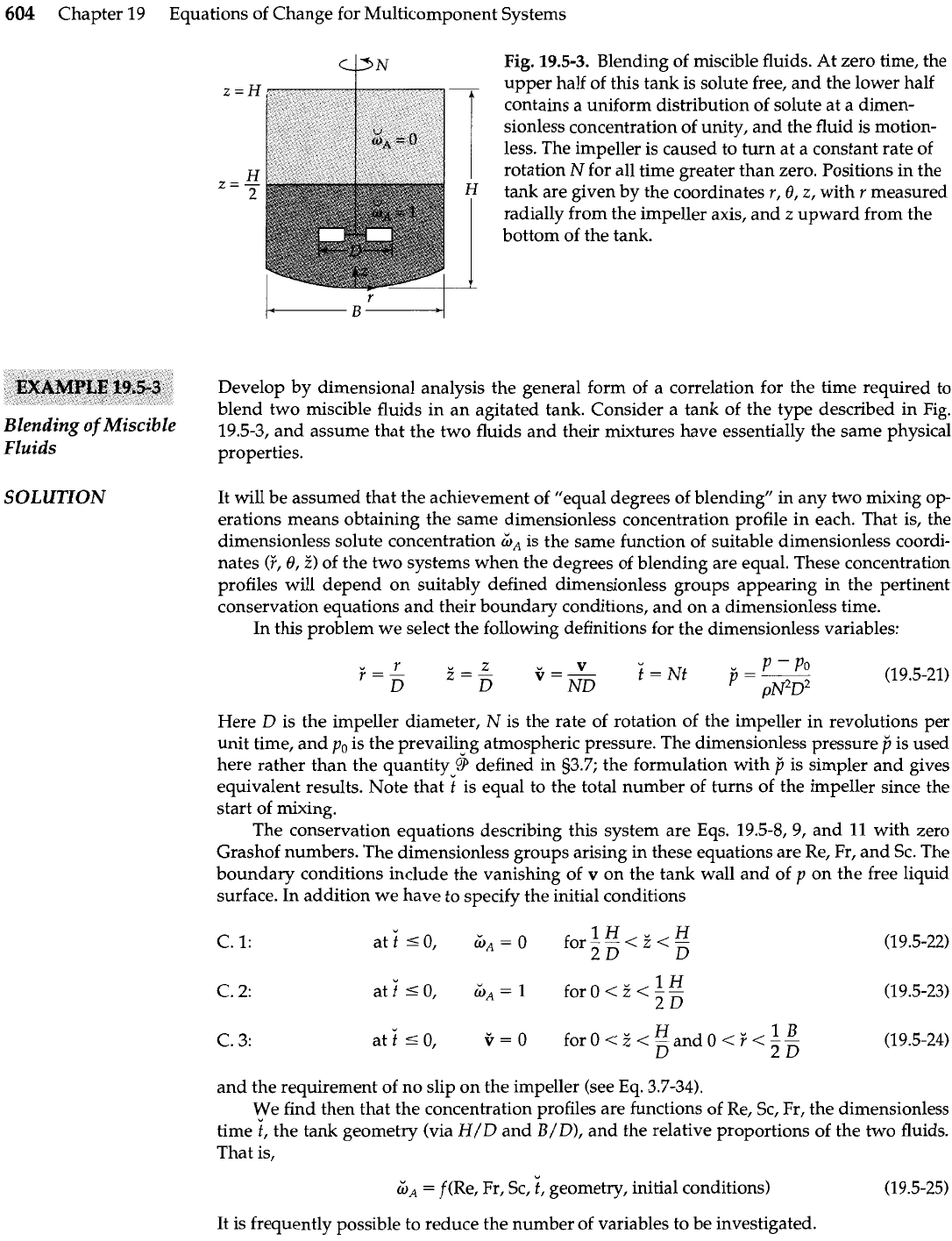
604
Chapter 19 Equations of Change for Multicomponent Systems
Fig.
19.5-3.
Blending of miscible fluids. At zero time, the
z
=
H
upper half of this tank is solute free, and the lower half
contains
a
uniform distribution of solute at a dimen-
sionless concentration of unity, and the fluid is motion-
less. The impeller is caused to turn at a constant rate of
H
rotation
N
for all time greater than zero. Positions in the
z=-
2
tank are given by the coordinates
r,
8,
z,
with
r
measured
radially from the impeller axis, and
z
upward from the
bottom of the tank.
Develop by dimensional analysis the general form of a correlation for the time required to
blend two miscible fluids in an agitated tank. Consider a tank of the type described in Fig.
of
19.5-3, and assume that the two fluids and their mixtures have essentially the same physical
Fluids
properties.
SOLUTION
It will be assumed that the achievement of "equal degrees of blending" in any two mixing op-
erations means obtaining the same dimensionless concentration profile in each. That is, the
dimensionless solute concentration
&,
is the same function of suitable dimensionless coordi-
nates
(?,
0,i)
of the two systems when the degrees of blending are equal. These concentration
profiles will depend on suitably defined dimensionless groups appearing
in
the pertinent
conservation equations and their boundary conditions, and on a dimensionless time.
In this problem we select the following definitions for the dimensionless variables:
Here D is the impeller diameter,
N
is the rate of rotation of the impeller in revolutions per
unit time, and
p,
is the prevailing atmospheric pressure. The dimensionless pressure
j3
is used
here rather than the quantity
9
defined in
53.7;
the formulation with
ji
is simpler and gives
equivalent results. Note that
i
is equal to the total number of turns of the impeller since the
start of mixing.
The conservation equations describing this system are Eqs. 19.5-8, 9, and
11
with zero
Grashof numbers. The dimensionless groups arising in these equations are Re, Fr, and Sc. The
boundary conditions include the vanishing of
v
on the tank wall and of
p
on the free liquid
surface. In addition we have to specify the initial conditions
C.
1:
1H H
atf 50, &,=O for--<?<-
20 D
(19.5-22)
C.
2:
1
H
att 50, 1 forO<i<--
20
(19.5-23)
and the requirement of no slip on the impeller (see Eq.
3.7-34).
We find then that the concentration profiles are functions of Re, Sc, Fr, the dimensionless
time
t,
the tank geometry (via H/D and B/D), and the relative proportions of the two fluids.
That is,
&,
=
f
(Re, Fr, Sc,
t,
geometry, initial conditions)
(19.5-25)
It is frequently possible to reduce the number of variables to be investigated.
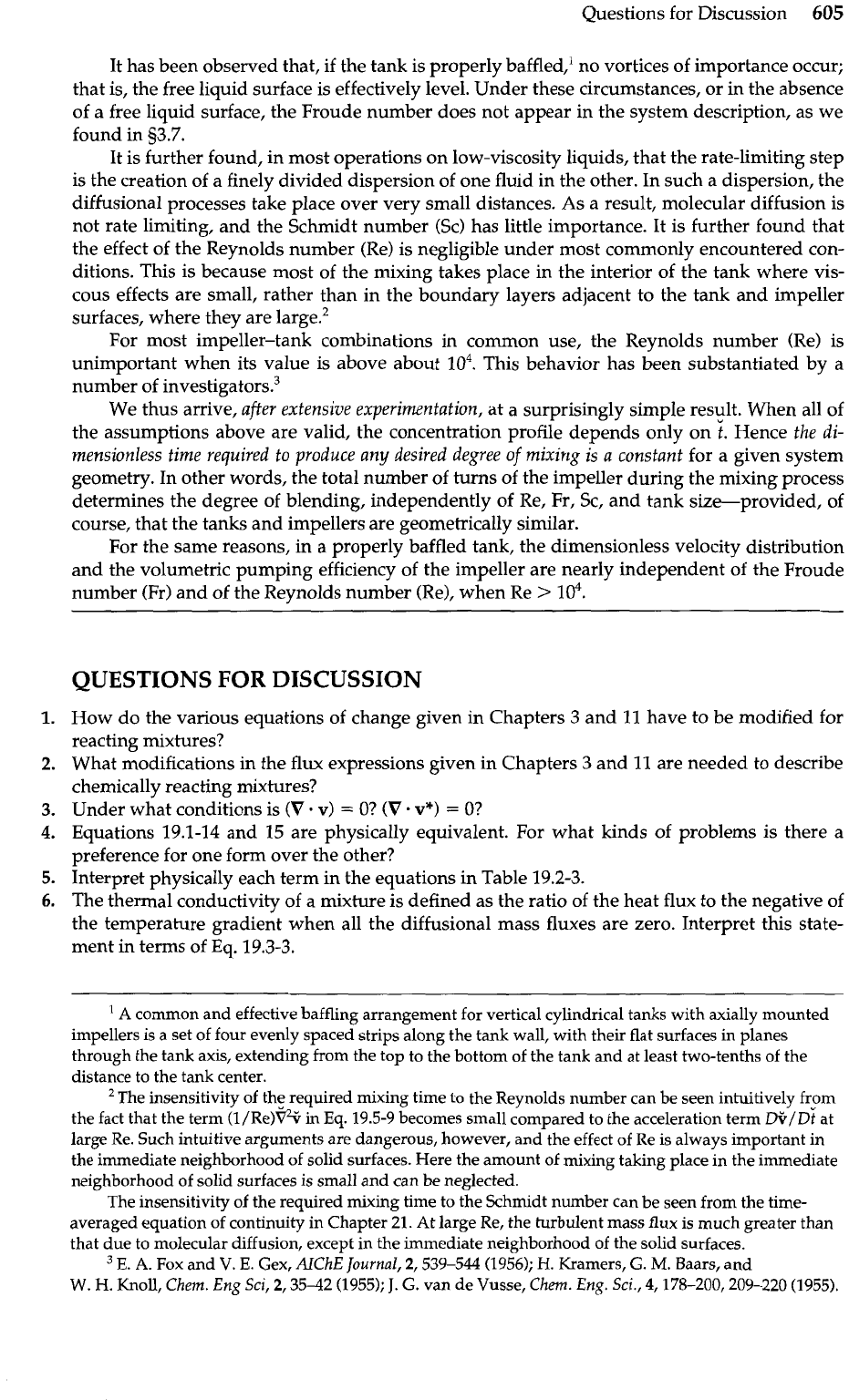
Questions for Discussion
605
It has been observed that, if the tank is properly baffled,' no vortices of importance occur;
that is, the free liquid surface is effectively level. Under these circumstances, or in the absence
of a free liquid surface, the Froude number does not appear in the system description, as we
found in
53.7.
It is further found, in most operations on low-viscosity liquids, that the rate-limiting step
is the creation of a finely divided dispersion of one fluid in the other. In such a dispersion, the
diffusional processes take place over very small distances. As a result, molecular diffusion is
not rate limiting, and the Schmidt number (Sc) has little importance. It is further found that
the effect of the Reynolds number (Re) is negligible under most commonly encountered con-
ditions. This is because most of the mixing takes place in the interior of the tank where vis-
cous effects are small, rather than in the boundary layers adjacent to the tank and impeIler
surfaces, where they are large.'
For most impeller-tank combinations in common use, the Reynolds number (Re) is
unimportant when its value is above about lo4. This behavior has been substantiated by a
number of
investigator^.^
We thus arrive,
after extensive experimentation,
at a surprisingly simple result. When all of
the assumptions above are valid, the concentration profile depends only on
I.
Hence
the di-
mensionless time required to produce any desired degree of mixing is
a
constant
for a given system
geometry. In other words, the total number of turns of the impeller during the mixing process
determines the degree of blending, independently of Re, Fr, Sc, and tank size-provided, of
course, that the tanks and impellers are geometrically similar.
For the same reasons,
in
a properly baffled tank, the dimensionless velocity distribution
and the volumetric pumping efficiency of the impeller are nearly independent of the Froude
number (Fr) and of the Reynolds number (Re), when Re
>
lo4.
QUESTIONS FOR DISCUSSION
1.
How do the various equations of change given in Chapters
3
and 11 have to be modified for
reacting mixtures?
2.
What modifications in the flux expressions given in Chapters 3 and
11
are needed to describe
chemically reacting mixtures?
3.
Under what conditions is
(V
.
v)
=
O?
(V
.
v")
=
O?
4.
Equations 19.1-24 and
15
are physically equivalent. For what kinds of problems is there a
preference for one form over the other?
5.
Interpret physically each term in the equations in Table 19.2-3.
6.
The thermal conductivity of a mixture is defined as the ratio of the heat flux to the negative of
the temperature gradient when all the diffusional mass fluxes are zero. Interpret this state-
ment in terms of Eq. 19.3-3.
A
common and effective baffling arrangement for vertical cylindrical tanks with axially mounted
impellers is a set of four evenly spaced strips along the tank wall, with their flat surfaces in planes
through the tank axis, extending from the top to the bottom of the tank and at least two-tenths of the
distance to the tank center.
The insensitivity of the required mixing time to the Reynolds number can
be
seen intuitively from
the fact that the term
(l/~e)?%
in
Eq.
19.5-9
becomes small compared to the acceleration term
LX/DZ
at
large Re. Such intuitive arguments are dangerous, however, and the effect of Re is always important in
the immediate neighborhood of solid surfaces. Here the amount of mixing taking place in the immediate
neighborhood of solid surfaces is small and can
be
neglected.
The insensitivity of the required mixing time to the Schmidt number can be seen from the time-
averaged equation of continuity in Chapter
21.
At large Re, the turbulent mass flux is much greater than
that due to molecular diffusion, except in the immediate neighborhood of the solid surfaces.
E.
A.
Fox and
V.
E.
Gex,
AlChE
Journal,
2,539-544 (1956);
H.
Kramers,
G.
M.
Baars, and
W.
H.
Knoll,
Chem.
Eng
Sci, 2,3542 (1955);
J.
G.
van de Vusse,
Chem.
Eng.
Sci., 4,178-200,209-220 (1955).
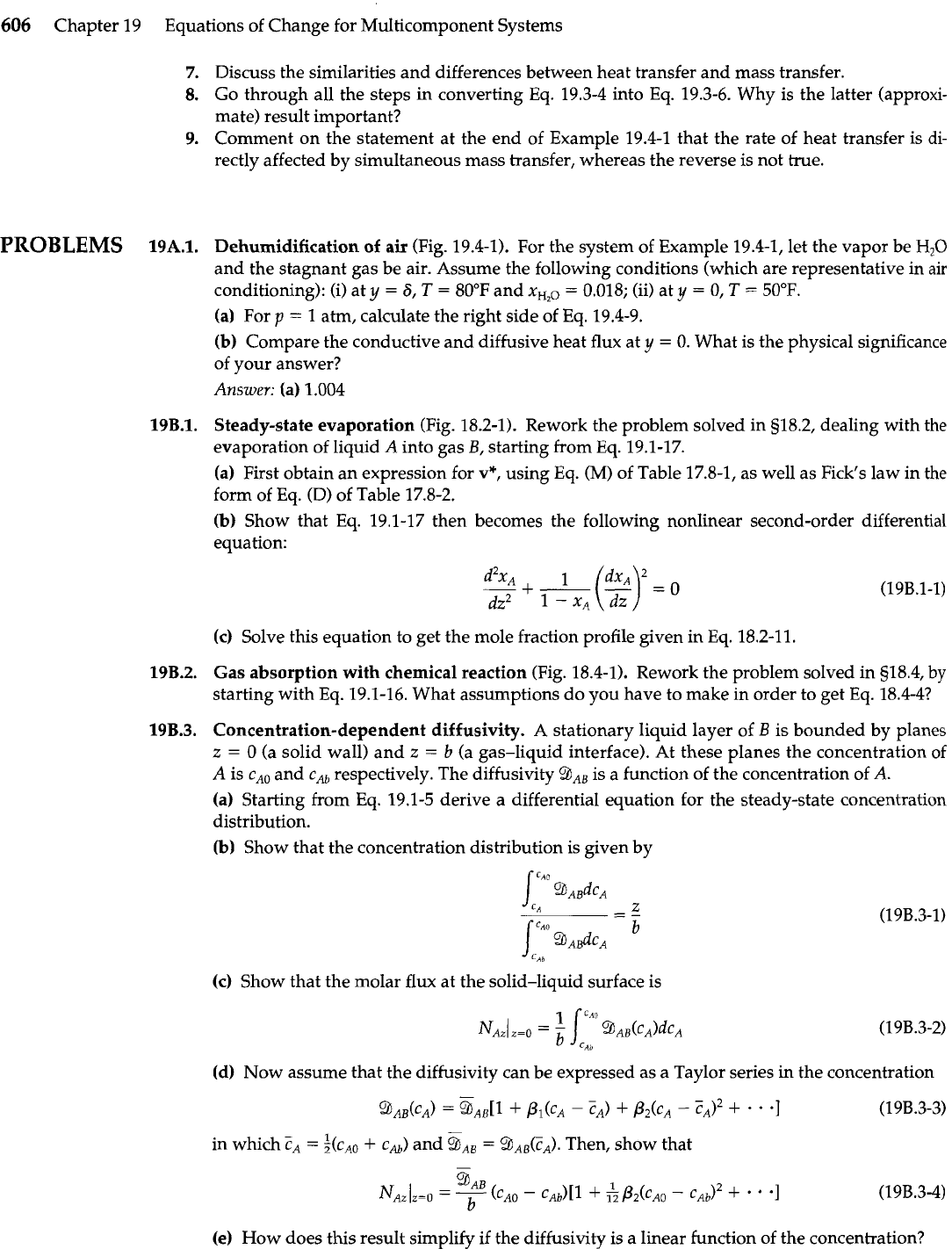
606
Chapter 19 Equations of Change for Multicomponent Systems
7.
Discuss the similarities and differences between heat transfer and mass transfer.
8.
Go through all the steps
in
converting Eq. 19.3-4 into Eq. 19.3-6. Why is the latter (approxi-
mate) result important?
9.
Comment on the statement at the end of Example 19.4-1 that the rate of heat transfer is di-
rectly affected by simultaneous mass transfer, whereas the reverse is not true.
PROBLEMS
19A.1.
Dehumidification of air (Fig. 19.4-1). For the system of Example 19.4-1, let the vapor be
H,O
and the stagnant gas be air. Assume the following conditions (which are representative in
air
conditioning): (i) at
y
=
6,
T
=
80°F and
XHzo
=
0.018; (ii) at
y
=
0,
T
=
50°F.
(a) For
p
=
1
atm, calculate the right side of Eq. 19.4-9.
(b) Compare the conductive and diffusive heat flux at
y
=
0. What is the physical significance
of your answer?
Answer:
(a) 1.004
19B.1.
Steady-state evaporation (Fig. 18.2-1). Rework the problem solved in 518.2, dealing with the
evaporation of liquid
A
into gas
B,
starting from Eq. 19.1-17.
(a) First obtain an expression for
v*,
using Eq.
(M)
of Table 17.8-1, as well as Fick's law in the
form of Eq.
(D)
of Table 17.8-2.
(b) Show that
Eq.
19.1-17 then becomes the following nonlinear second-order differential
equation:
(c)
Solve this equation to get the mole fraction profile given in Eq. 18.2-11.
19B.2.
Gas absorption with chemical reaction (Fig. 18.4-1). Rework the problem solved in 518.4,
by
starting with Eq. 19.1-16. What assumptions do you have to make in order to get Eq. 18.4-4?
19B.3.
Concentration-dependent diffusivity. A stationary liquid layer of
B
is bounded by planes
z
=
0 (a solid wall) and
z
=
b
(a gas-liquid interface). At these planes the concentration of
A
is cAo and
CAb
respectively. The diffusivity
9AB
is a function of the concentration of
A.
(a) Starting from Eq. 19.1-5 derive a differential equation for the steady-state concentration
distribution.
(b) Show that the concentration distribution is given by
(c)
Show that the molar flux at the solid-liquid surface is
(dl Now assume that the diffusivity can be expressed as a Taylor series in the concentration
in which
2,
=
+(cAo
+
c,)
and
gA,
=
QAB(CA). Then, show that
(e) How does this result simplify if the diffusivity is a linear function of the concentration?
